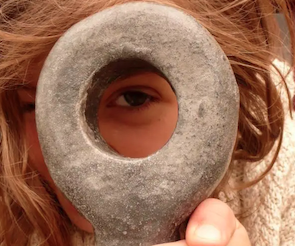AMPLITUDE MODULATION SYNTHESIS.

This set up involves two analog sensors; a pressure sensor (in my case 2), alongside a potentiometer, this set up involves controlling the amplitude of one signal using the other signal.
In the patch there is a signal generator at the top that is producing a sine tone (the carrier), this tone’s frequency is controlled by the first analog input, which in this case is the pressure sensor. As the pressure applied changes, the sensor outputs varying voltage levels that are allocated to different frequency values, allowing the pitch of the tone to fluctuate in response to how much force is applied. The carrier’s amplitude is modulated by another signal (the modulator), which is controlled by the potentiometer, the frequency of this signal can be adjusted to modulate at slower and higher rates, creating a rather beautiful tremolo effect.
Throughout this task I was constantly playing around the values of the signal to map the sensor’s range into a pitch range. Through changing these values I was able to control the sensitivity of the pressure sensor, the higher the first number, the more sensitive the sensor is. I was also able to control the frequency range meaning I was able to create these very different sounding tones through just changing one small part of the code. This made for an interesting task, as I was able to grasp a deeper understanding on AM synthesis through being able to control it’s properties to have a specific effect, now knowing how and why it is having that effect. When increasing the offset number (the bottom number) the entire pitch range moves upwards, and vice versa when decreasing the number, this is very useful for really manipulating your sound to achieve the low of high ends you want.


AM Synthesis with an external input.
The last section of the task involved using an external audio input to try AM on a real audio stream, for this I used existing music coming through my laptop to sample and add effects to. The AM added an interesting tremolo effect which the speed of, was controlled using the potentiometer. This was the first time using samples within Pd and I found myself feeling very inspired with the possibilities it offers. It gave me an insight into how I can integrate my work into Pd and this medium of code, it allowed me to understand how it can be used to manipulate existing sources (my own or someone else’s) to create something entirely new, in a interesting, generative way.
After completing the original task I decided to add a second pressure sensor and allocate it a different frequency range, in order to play and hear both sensors at the same time. (Can be seen in the video above). This made for an intriguing sound, almost harmonic at points, however weaving in and out.
Although this was not my first time learning about AM synthesis, this process has played a major part in my understanding of it, purely because of having this sequential, visual representation of the process. I am making each change consciously and am able to both see and hear how the sound is being controlled through my own choices and manipulation. This is one thing I have noticed about Pure data, and the tasks I have complete so far, it has really expanded my knowledge and understanding on concepts I have been slightly aware of before. Regardless of the level of prior knowledge, it has deepened my perception on this more kind of technical work, simply through stripping it back to basics and building it up, seeing how each small change effects the final product.
This task, specifically with the external input felt like the most complex one yet, and is still only very basic, however as I continue making each set up, I find there is more of a need for context around Pure data, which I thought I would find off putting, yet it’s quite the opposite. I have decided to choose this elective for my submission due to this new found inspiration. As I progress with each task, my confidence builds and I feel enthusiastic to combine my multi media skills within this project to make an intriguing final piece.
